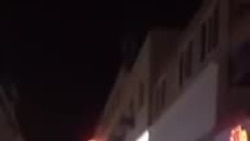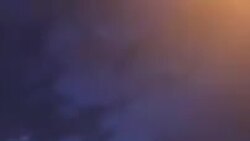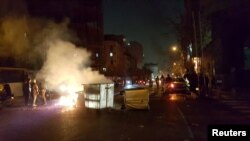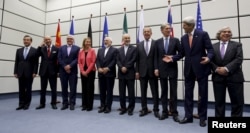For the latest developments in Farsi, please check @VOAIran and ir.voanews.com
Iranian President Hassan Rouhani has said his people have the right to protest and criticize the government, in his first public response to nationwide anti-establishment protests that have stretched into a fourth day.
Iranian state media said Rouhani made the conciliatory comments about the protests in remarks to his Cabinet on Sunday. But they also quoted Rouhani as saying the protesters should focus on solving the country's problems and improving people's lives.
In similar remarks posted on his Twitter account in Farsi, Rouhani said social unrest and destruction of public property are unacceptable.
Iran's biggest anti-government demonstrations since the 2009 protests against the disputed re-election of former president Mahmoud Ahmadinejad continued Sunday, with hundreds of people joining street rallies in several parts of the country, as seen in video clips shared with VOA Persian by residents of those locations.
One video clip sent to VOA Persian showed protesters overturning an Iranian police van on central Tehran's Valiasr Street.
Other video clips showed people chanting "death to the dictator" in the city of Urmia in northwestern Iran's West Azerbaijan province, and another group of protesters chanting "don't fear, we are all together" in the city of Shooshtar in western Iran's Khuzestan province.
Protests in Urmia:
Protests in Shooshtar:
In his Sunday comments reported by state media, Iranian President Rouhani also criticized U.S. President Donald Trump, saying he has "no right" to sympathize with the Iranian people because Trump had called Iran a "terrorist" nation several months ago.
In a tweet posted earlier on Sunday, Trump said the Iranian people are "finally getting wise as to how their money and wealth is being stolen and squandered on terrorism." Trump added that his administration is "watching very closely" for any human rights violations by Iranian authorities responding to the protests.
The response of Iranian security forces to the four days of demonstrations has been relatively restrained compared to the violent crackdown on the 2009 protests.
In an October speech outlining his Iran strategy, Trump said U.S. policy is based on what he called "a clear-eyed assessment of the Iranian dictatorship, its sponsorship of terrorism, and its continuing aggression in the Middle East and all around the world." He did not use the term "terrorist" to describe the Iranian nation or its people.
Iranian callers to the Sunday edition of VOA Persian's Straight Talk program disagreed about whether foreign intervention in the protests is desirable.
A caller named Farhad from Tehran said, "Right now, we are on the streets for a revolution. (President) Trump, you pledged to help us. Please do so."
But the next caller, named Siamak and also from Tehran, said Farhad was mistaken. "We should take care of our own business," he said.
In other Sunday developments, the Iranian government blocked people from using social media platform Instagram and messaging app Telegram.
Iranian state television said authorities were "temporarily" blocking both applications to "maintain peace." Many protesters had been using the apps to upload or share photos and videos from the demonstrations.
"Iranian authorities are blocking access to Telegram for the majority of Iranians after our public refusal to shut down," said Telegram CEO Pavel Durov in a Sunday tweet.
President Trump criticized the Iranian moves against social media in another Sunday tweet.
He said Iran, which the U.S. considers to be world's No. 1 state sponsor of terrorism, has "now closed down the Internet so that peaceful demonstrators cannot communicate. Not good!"
Prominent Iranian cleric Ayatollah Mohsen Araki told thousands of pro-government demonstrators in Tehran on Saturday that "the enemy" wanted to use social media and economic issues to "foment a new sedition."
Protesters will 'pay the price'
Earlier Sunday, Iran's interior minister warned that those who "disrupt the order and break the law must be responsible for their behavior and pay the price." Abdolrahman Rahmani Fazli, in a statement on state television, said "fear and terror will definitely be confronted."
The protests, which began Thursday in the northeastern city of Mashhad, initially appeared to be a reaction to high food prices and unemployment. But they quickly evolved into expressions of anger against Iran's clerical leadership, including President Rouhani, who won re-election in May with promises to revive the economy.
Iran's 2015 nuclear deal is seen as Rouhani's major achievement. The deal, made with the U.S. and five other world powers, curbed Iran's nuclear activities in exchange for relief from international sanctions. But economic growth has been too slow for many Iranians who have struggled to cope with the high cost of living.
Iran's unemployment rate is 12.4 percent, its economy is stagnant and inflation is rampant.
As a counter to the protests, separate state-sponsored rallies took place around the country on Saturday to mark the end of the unrest that shook the country in 2009. State television reported pro-government rallies were held in about 1,200 cities and towns.
Two protesters shot
Two protesters were shot during demonstrations on Saturday — killings an Iranian official blamed on "foreign agents."
"No shots were fired by the police and security forces," said Habibollah Khojastehpour, a deputy governor of the province where the protesters were killed. "We have found evidence of enemies of the revolution, Takfiri groups and foreign agents in this clash," he said in an interview on state television Sunday.
The shootings happened in the western town of Dorud. VOA's Persian service identified the victims as Hamzeh Lashni and Hossein Reshno after a reporter spoke to the victims' families.
Video posted to social media purported to show the two victims following the shootings. Other online video clips showed thousands of people protesting in several cities throughout Iran on Saturday — including some people attacking government buildings and violently confronting police.
VOA Persian and RFE/RL contributed to this report.
For the latest developments in Farsi, please check @VOAIran and ir.voanews.com
Timeline of Unrest in Iran
2013
June — Cleric Hassan Rouhani becomes president.
September — Rouhani tells U.S. news channel NBC that Iran will not build any nuclear weapons. He offers "time-bound and result-oriented" talks on the nuclear issue during a speech at the United Nations.
November — Iran agrees to stop all uranium enrichment above 5 percent and allow U.N. inspectors access to its nuclear facilities. In return, the five permanent members of the U.N. Security Council — the U.S. Britain, Russia, China and France — in addition to Germany, agree to lift $7 billion of economic sanctions.
2014
April — The International Atomic Energy Agency confirms Iran has neutralized 50 percent of its stockpile of highly enriched uranium.
2015
July — Iran and the P5+1 reach a final deal on curbing Iran's nuclear program in exchange for lifting international economic sanctions.
2016
January — Economic sanctions on Iran are lifted.
December — Economic sanctions remain lifted, though the U.S. Senate extends the Iran Sanctions Act, which penalizes U.S. companies for doing business with Tehran.
2017
May — Rouhani is re-elected president.
Dec. 28 — Protests erupt in Mashhad, Iran's second-largest city. Small rallies are held in smaller cities nearby. In addition to demanding economic reform, protesters shout "Death to Rouhani." "Death to the dictator."
Dec. 29 — Protests spread to larger cities, including Qom, Isfahan and Zahedan. A few people are arrested in Tehran where smaller rallies are taking place.
Dec. 30 — Two protesters are killed in western Iran. At least 200 people are arrested in Tehran, but information on the number of people arrested around the country is unavailable. Videos posted on social media show unprecedented images of protesters taking down banners and posters of Ayatollah Ali Khamenei. Internet access is shut down in many parts of the country.
Dec. 31 — Rouhani acknowledges the protests. U.S. President Donald Trump tweets support for the protesters and warns that the world was watching.


















